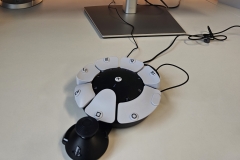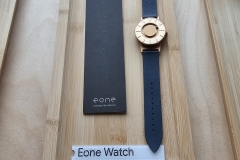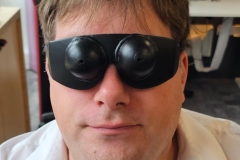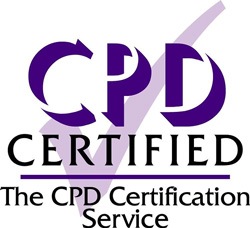Experiencing Google’s Accessibility Discovery Centre
Bascule recently had the privilege of visiting Google’s HQ in Kings Cross, London, where we were given a tour of the Accessibility Discovery Centre (ADC). Situated on the seventh floor of Google's offices (with multiple banks of available lifts!), the ADC is a space dedicated to exploring the diverse needs of people with disabilities and showcasing cutting-edge technologies.
Upon arrival, we were introduced to Hans and Praneeth, who shared insights into the development of the ADC, its purpose, key achievements, and the story behind the creation of its logo. They then showed us a large tactile model of the logo displayed on the wall. Next to it was a smaller, identical version. Praneeth explained that while the original large model was designed for accessibility, its size made it difficult for some people to interact with, leading to the creation of the smaller version.
He emphasised that accessible development is an ongoing process of recognising where changes are needed and making improvements accordingly. Accessibility, he pointed out, is constantly evolving—an idea that resonated throughout the rest of the tour.
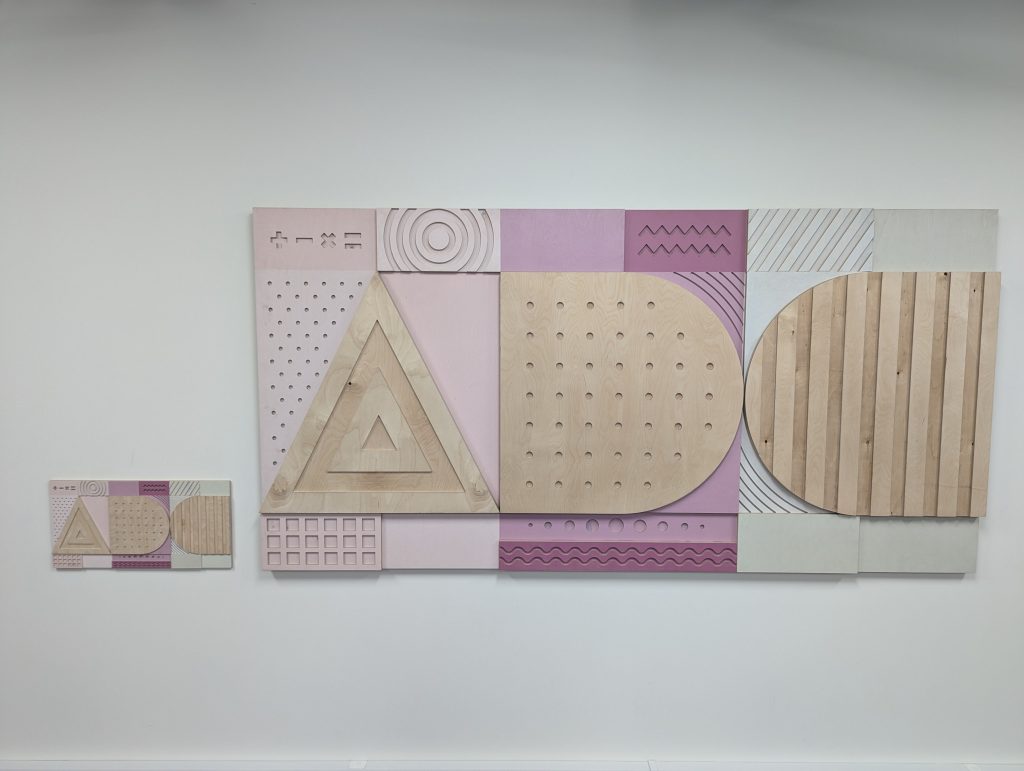
We were then taken to a range of different workstations in the assistive experience area of the centre.
The first area we were shown was the arcade. Here, we experienced three gaming stations, each of which displayed an interactive model of accessible technology.
The first, (and arguably most impressive), was a driving game that was controlled solely by vision, tracking the movement of your eyes. The tracker uses the precise area of your focus to steer a racing car around a track. Most powerfully, they showed a video of young person with significant motor function impairment happily driving the car around the track. His time has yet to be beaten!
The second demonstrated technologies that would allow someone with limited dexterity, or inhibited use of limbs, to play a game using impact pads, (here I am demonstrating the head pad- (left)). You can’t see the pad but it is behind my left ear and I was bashing the button with my head quite merrily!
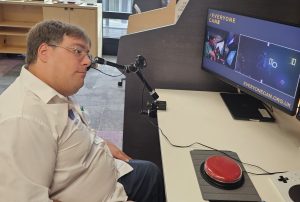
The third demonstrated a console control pad, with buttons on a circular mat that would also enable someone with limited dexterity to play, with adaptable, removeable, customisable, larger buttons than those ordinarily found on gaming consoles.
I couldn’t help but imagine how these assistive technologies would have made me feel as a child growing up with limited dexterity. They certainly demonstrated huge potential to make gaming more accessible to all, not to mention the potential for other technology.
After that we looked at a whole other range of assistive technologies – some of which were simply based on engineering excellence, such as the self-steadying spoon (a spoon that, regardless of how your hands and wrists moved still steadily held marbles within). We also looked at items including vibrating alarm clocks and accessible watches for people with sight loss- such as the Eone | The Bradley Timepiece (eone-time.com) . After this, we tried glasses on to experience the differences in various of visual impairments- here I am experiencing what it is like to have tunnel vision. This is not substitute for living with a visual impairment, however, it a little bit of insight into it.
Finally, we were able to learn about the assistive technologies, apps and features available via Google Chrome and Android, and I was incredibly impressed at the number of features and apps that are already available via Chrome and Android for free (details follow at the end of the blog). We also looked at screen readers, speech to text features and various other home technologies for those with sight and hearing impairments. To me, this is further evidence that in many cases, reasonable adjustments might need not cost money, we may just need to make people out there aware of what is already available.
Overall, the tour was an inspiring and exciting experience that everyone should have. Whilst observing the technologies and thinking about how beneficial they could be for people with disabilities, it was also occurring to me, how important the development of accessibility is, and has already been, to the whole world.
For example, people often forget that the electric toothbrush, the typewriter (and therefore keyboard itself), audio books and automated doors, are just some of the inventions originally intended to develop accessibility for people with disabilities. These have gone on to improve the way that we all live. I could easily imagine a world whereby we use eye trackers similar to those in the game I experienced, to control a whole range of different forms of technology.
Accessibility is an incredibly important part of research and development, ensuring people can live more independently, inclusively and productively, whilst also having the potential to improve how we utilise digital tools, and access information, all whilst promoting equality.
Chris Jay, Managing Director, Bascule Disability Training.
Follow these links for full instructions on accessibility features currently available for Chrome & Android .


